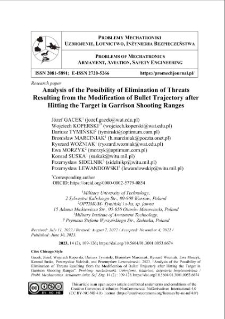Nasza Biblioteka Cyfrowa udostępnia 1 868 obiektów cyfrowych
Obiekt
Tytuł: Analysis of the Possibility of Elimination of Threats Resulting from the Modification of Bullet Trajectory after Hitting the Target in Garrison Shooting Ranges ; Analysis of the Possibility of Elimination of Threats Resulting from the Modification of Bullet Trajectory after Hitting the Target in Garrison Shooting Ranges
Tytuł odmienny:
Analiza możliwości eliminacji zagrożeń wynikających ze zmiany trajektorii pocisków po trafieniu w tarczęna strzelnicach garnizonowych ; Analiza możliwości eliminacji zagrożeń wynikających ze zmiany trajektorii pocisków po trafieniu w tarczęna strzelnicach garnizonowych
Współtwórca:
Wojciech KOPERSKI, Dariusz TYMIŃSKI, Bronisław MARCINIAK, Ryszard WOŹNIAK, Ewa MORZYK, Konrad SUSKA, Przemysław SIDELNIK, Przemysław LEWANDOWSKI ; Wojciech KOPERSKI, Dariusz TYMIŃSKI, Bronisław MARCINIAK, Ryszard WOŹNIAK, Ewa MORZYK, Konrad SUSKA, Przemysław SIDELNIK, Przemysław LEWANDOWSKI
Abstrakt:
During shooting operations in garrison shooting ranges, a phenomenon of random deflection of the bullet flight path was noticed which may cause secondary reflections from accidentally hit technical and ballistic shooting range elements and the ground of the actual plane of the shooting range (ricochets posing a threat to people and property within the shooting range and safety zones). Minimisation of this phenomenon must be considered during the design and operation of the shooting ranges. In 2020-2022 the Military Institute of Armament Technology (Zielonka, Poland) carried out tests with the aim of determining the impact of the shooting target or military target material or design (hereinafter referred to as the targets) on the risk of occurrence of modifications of bullet trajectory that cause the bullets to leave the shooting zone. The paper presents example results of these tests that show, but are not limited to, that the reasons to modify the direction of the bullet path after target penetration and any ricochets include: target material (flat or corrugated sheet metal, cardboard, plywood, etc.), target wooden legs, and even metal elements fixing the legs to the target. On the basis of the test it was shown that the metal targets prohibited on intermediate lines may cause significant deflections of the bullet flight path after penetration and dangerous ricochets. Due to the reason presented above, the metal targets are placed on the last line of targets before the main bullet trap only where the technical and ballistic parameters of the bullet trap ensure that any ricochets are captured. It was stated that the contact targets used on intermediate target lines and provided with wooden legs may cause bullet trajectory changes comparable to or even greater than in the case of the prohibited metal targets. To this end it is advisable to establish legal framework covering the ballistic inspection of the target materials to be used in garrison shooting ranges.
;
During shooting operations in garrison shooting ranges, a phenomenon of random deflection of the bullet flight path was noticed which may cause secondary reflections from accidentally hit technical and ballistic shooting range elements and the ground of the actual plane of the shooting range (ricochets posing a threat to people and property within the shooting range and safety zones). Minimisation of this phenomenon must be considered during the design and operation of the shooting ranges. In 2020-2022 the Military Institute of Armament Technology (Zielonka, Poland) carried out tests with the aim of determining the impact of the shooting target or military target material or design (hereinafter referred to as the targets) on the risk of occurrence of modifications of bullet trajectory that cause the bullets to leave the shooting zone. The paper presents example results of these tests that show, but are not limited to, that the reasons to modify the direction of the bullet path after target penetration and any ricochets include: target material (flat or corrugated sheet metal, cardboard, plywood, etc.), target wooden legs, and even metal elements fixing the legs to the target. On the basis of the test it was shown that the metal targets prohibited on intermediate lines may cause significant deflections of the bullet flight path after penetration and dangerous ricochets. Due to the reason presented above, the metal targets are placed on the last line of targets before the main bullet trap only where the technical and ballistic parameters of the bullet trap ensure that any ricochets are captured. It was stated that the contact targets used on intermediate target lines and provided with wooden legs may cause bullet trajectory changes comparable to or even greater than in the case of the prohibited metal targets. To this end it is advisable to establish legal framework covering the ballistic inspection of the target materials to be used in garrison shooting ranges.
Miejsce wydania:
Warszawa
;
Warszawa
Wydawca:
Wojskowa Akademia Techniczna ; Wojskowa Akademia Techniczna
Data utworzenia:
Data złożenia:
Data akceptacji:
Data wydania:
Rozmiar:
Identyfikator:
oai:ribes-88.man.poznan.pl:2676
Sygnatura:
doi:10.5604/01.3001.0053.6674 ; doi:10.5604/01.3001.0053.6674
ISSN elektroniczny:
ISSN drukowany:
Język:
Licencja:
kliknij tutaj, żeby przejść ; kliknij tutaj, żeby przejść
Właściciel praw:
Wojskowa Akademia Techniczna ; Wojskowa Akademia Techniczna
Strona początkowa:
Strona końcowa:
Tom:
Czasopismo:
Słowa kluczowe:
ballistics, shooting range, ricochet ; ballistics, shooting range, ricochet
Kolekcje, do których przypisany jest obiekt:
Data ostatniej modyfikacji:
15 paź 2025
Data dodania obiektu:
15 paź 2025
Liczba wyświetleń treści obiektu:
0
Wszystkie dostępne wersje tego obiektu:
https://ribes-88.man.poznan.pl/publication/3009
Wyświetl opis w formacie RDF:
Wyświetl opis w formacie OAI-PMH:
Obiekty Podobne
Józef GACEK Paweł MAZUR
Józef GACEK Małgorzata PAC
Józef GACEK Krzysztof MOTYL, Konrad SIENICKI ,Bronisław WAJSZCZYK
Józef GACEK Bronisław MARCINIAK, Ryszard WOŹNIAK

